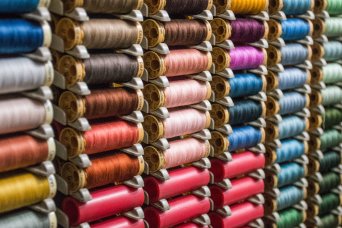- About
- Topics
- Picks
- Audio
- Story
- In-Depth
- Opinion
- News
- Donate
- Signup for our newsletterOur Editors' Best Picks.Send
Read, Debate: Engage.
| topic: | Sustainable Development |
|---|---|
| located: | India |
| editor: | Bindu Gopal Rao |
The textile industry in India, which has a four percent share of the global trade in textiles and apparel, is expected to grow by a compound 10 percent annually to reach $190 billion by 2026. Spurred on by massive domestic and foreign demand, the industry also provides a source of employment and attracts a lot of investment. However, this burgeoning industry has a high reliance on coal and natural gas to supply electricity and heat, which adds to its also increasing carbon footprint.
Globally, the textile and garment sector accounts for six to eight percent of total carbon emissions, amounting to 1.7 billion tonnes of annual CO2 emissions per year. One single cotton t-shirt requires 2,700 litres of water, while 5.9 trillion litres of water are used annually for dying fabric, according to the World Resources Institute. The dying and treatment process of textiles contributes 20 percent of industrial water pollution in the world and 8,000 synthetic chemicals are used to turn raw materials into textiles.
The industry also has an array of other issues, like the complexity of its supply-chain networks and the panoply of stakeholders for raw materials; any sustainability measures therefore require the involvement of all contributors, as well as a transparent system for tracing emissions contributions and changes.
With the high environmental impact, but large room for improvement, it is very probable that measures to implement sustainability in the textiles sector will have a significant impact. With this goal in mind, the government's Ministry of Textiles has signed a cooperation agreement between the United Nations’ Environment Programme and The Cotton Corporation of India to ensure circularity and mainstream sustainability in the supply chain.
Conscious manufacturers are hence making concerted efforts to introduce sustainability by using innovative materials, using safe dyes, reducing water and energy consumption, treating waste material and ensuring a greater focus on reducing, reusing and recycling.
An important aspect is shifting gears from linear to circular operations, ensuring that both pre-consumer and post-consumer waste are controlled. Zero Liquid Discharge, for instance, is a wastewater treatment process that removes all liquid discharge from a system. Apart from prioritising organic fabrics, the focus of the sector is all about conserving the natural environment. Other projects, like processing PET bottles to make recycled polyester fibres, are also underway.
This has triggered the movement towards slow fashion that works on a ‘fit-to-demand’ model, reducing surplus and investing in garments that have a long life. With new innovations like 3D printing and new age fabrics made from hemp and bamboo, these changes come as first steps in a long journey towards sustainability
Photo by Héctor J. Rivas

